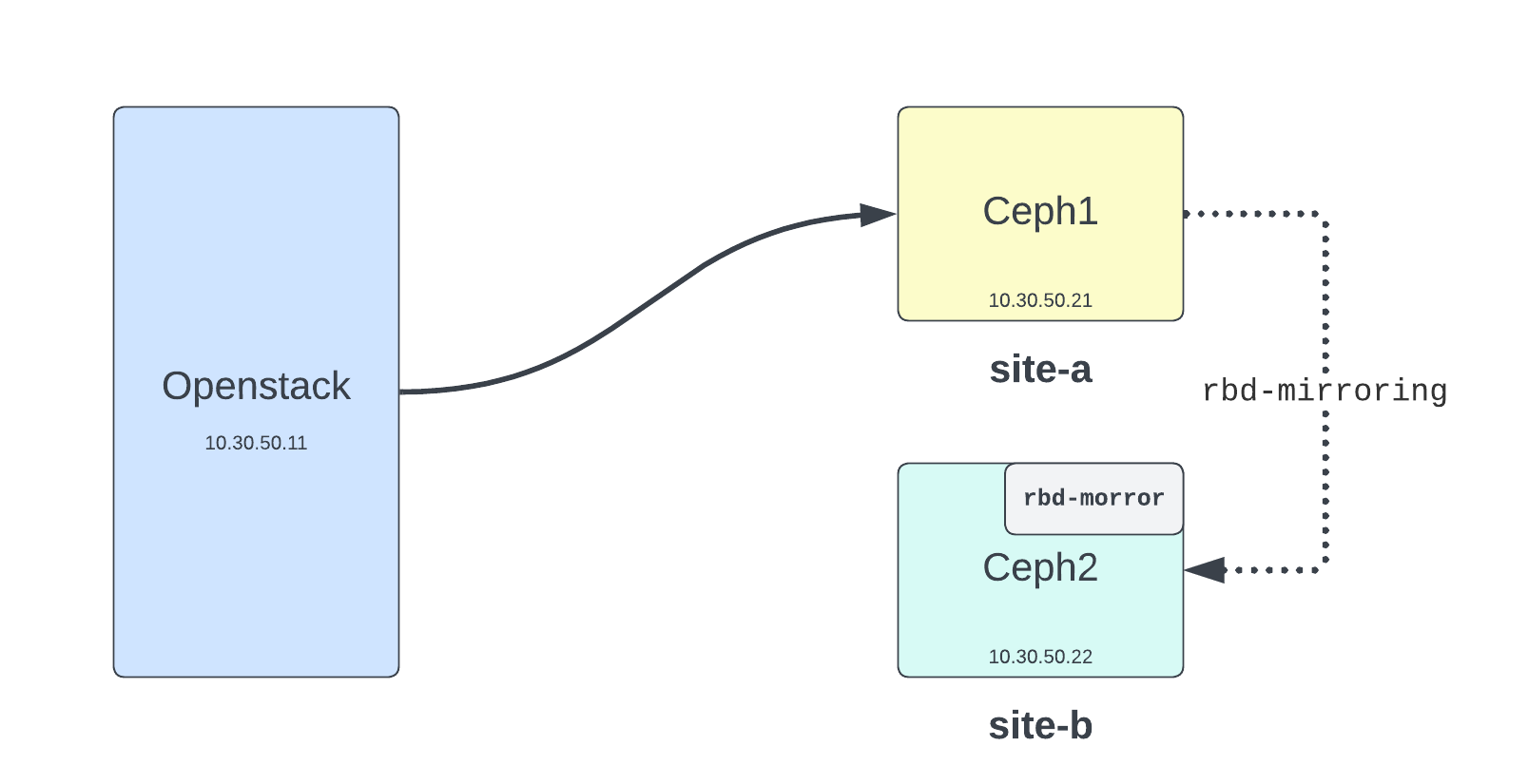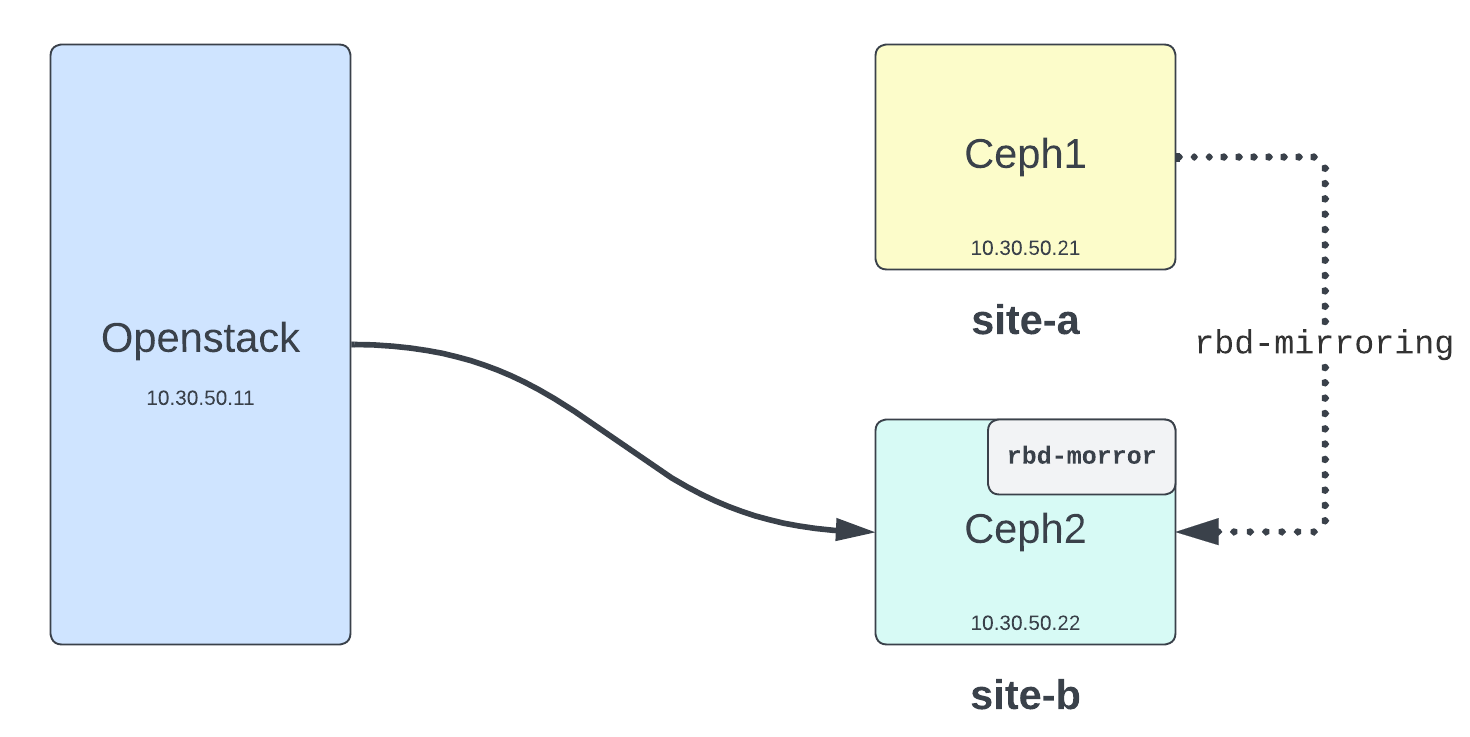
Openstack Disaster Recovery with Ceph RBD Mirror
- 6 minsIn a previous blog, I have explained how to set up Ceph RDB Mirror for Storage on-way replication. In this blog I will set up an openstack cluster and do a real scenario of failover from primary ceph storage to the secondary ceph storage. Just mimic disaster recovery where the primary ceph cluster goes down and how to point your all opentack vms to the secondary cluster and bring them up.
Scope
- Working Openstack environment (In my case kolla-ansible)
- Two working ceph1 and ceph2 cluster (with RBD mirror setup)
- For normal failover from ceph1 to ceph2 storage
- Shutdown all the VMs
- Point openstack to the secondary ceph
- Demote Primary ceph Pools/Images
- Promote Seconday ceph Pools/Images
- Start all the VMs
Setup Ceph Auth on Seconday Cluster
This is personal choice but in my case to reduce typing I’ve export/import auth creds from primary cluster to Secondary cluster. Both clusters have similar auth/keys so I don’t need to maintain keyring files on openstack. Just need to switch ceph.conf file during failover.
On Primary ceph1
$ ceph auth export client.nova -f /root/ceph-auth-nova.txt
$ ceph auth export client.cinder -f /root/ceph-auth-cinder.txt
Copy both files to Secondary ceph2 cluster and import them.
$ ceph auth import -i /root/ceph-auth-nova.txt
$ ceph auth import -i /root/ceph-auth-cinder.txt
NOTES: I am using pool name “vms” to store nova instances. Just make sure you have that pool in secondary cluster.
Setup kolla-ansible to use ceph storage
In global.yml file
nova_backend_ceph: "yes"
cinder_backend_ceph: "yes"
Copy ceph.conf (from primary ceph1 cluster) and keyring files in nova and cinder directory sturcture of kolla-ansible
$ tree /etc/kolla/config/nova
/etc/kolla/config/nova
├── ceph.client.cinder.keyring
├── ceph.client.nova.keyring
└── ceph.conf
$ tree /etc/kolla/config/cinder/
/etc/kolla/config/cinder/
├── ceph.conf
└── cinder-volume
├── ceph.client.cinder.keyring
NOTES: Make sure ceph.conf coming from Active or Primary cluster because it will point your openstack to ceph cluster.
Run kolla-ansible to push changes.
$ kolla-ansible -i <inventory_file> reconfigure -t nova
Create few VMs for POC testing.
$ openstack server create --image ubuntu --flavor m1.small --network net-vlan40 --key kolla-key vm01
$ openstack server create --image ubuntu --flavor m1.small --network net-vlan40 --key kolla-key vm02
$ openstack server create --image ubuntu --flavor m1.small --network net-vlan40 --key kolla-key vm03
Check status of VMs.
$ openstack server list
+--------------------------------------+-------+--------+------------------------+--------+----------+
| ID | Name | Status | Networks | Image | Flavor |
+--------------------------------------+-------+--------+------------------------+--------+----------+
| d4743fb5-c314-46ee-8f84-323896936d77 | vm01 | ACTIVE | net-vlan40=10.40.40.28 | ubuntu | m1.small |
| 86d463f1-e4fc-457f-962e-5270007694d3 | vm02 | ACTIVE | net-vlan40=10.40.40.15 | ubuntu | m1.small |
| cbad8833-54d0-4ffa-a9fa-0f26d80dfd02 | vm03 | ACTIVE | net-vlan40=10.40.40.35 | ubuntu | m1.small |
+--------------------------------------+-------+--------+------------------------+--------+----------+
Verify ceph clusters

Check replication between site-a and site-b ceph storage cluster.
[site-a]$ rbd -p vms ls
86d463f1-e4fc-457f-962e-5270007694d3_disk
cbad8833-54d0-4ffa-a9fa-0f26d80dfd02_disk
d4743fb5-c314-46ee-8f84-323896936d77_disk
[site-b]$ rbd -p vms ls
86d463f1-e4fc-457f-962e-5270007694d3_disk
cbad8833-54d0-4ffa-a9fa-0f26d80dfd02_disk
d4743fb5-c314-46ee-8f84-323896936d77_disk
Check lock status of VMs disk on ceph. You can noticed openstack holding primary ceph cluster disks.
[site-a]$ for qw in `rbd -p vms ls`; do rbd lock list --image vms/$qw; done
There is 1 exclusive lock on this image.
Locker ID Address
client.25650 auto 140453684972992 10.30.50.11:0/2295878674
There is 1 exclusive lock on this image.
Locker ID Address
client.25643 auto 140053850363040 10.30.50.11:0/782370625
There is 1 exclusive lock on this image.
Locker ID Address
client.25651 auto 140572199228800 10.30.50.11:0/950338816
On secondary ceph cluster showing own IPs in lock status.
[site-b]$ for qw in `rbd -p vms ls`; do rbd lock list --image vms/$qw; done
There is 1 exclusive lock on this image.
Locker ID Address
client.22536 auto 94462019434112 10.30.50.22:0/4140521941
There is 1 exclusive lock on this image.
Locker ID Address
client.22536 auto 94462019432960 10.30.50.22:0/4140521941
There is 1 exclusive lock on this image.
Locker ID Address
client.22536 auto 94461980277376 10.30.50.22:0/4140521941
Another command to verify primary onwership of disk images.
[site-a]$ for qw in `rbd -p vms ls`; do rbd info vms/$qw | grep "mirroring primary"; done
mirroring primary: true
mirroring primary: true
mirroring primary: true
[site-b]$ for qw in `rbd -p vms ls`; do rbd info vms/$qw | grep "mirroring primary"; done
mirroring primary: false
mirroring primary: false
mirroring primary: false
Test ceph failover
We are going to do normal failover where we will demote/promote cluster to gradually shift VMs to seconady cluster.
First Power-off all VMs
$ nova stop vm01 vm02 vm03
Check ceph lock status. You noticed no lock found on primary ceph because all VMs powered-off.
[site-a]$ for qw in `rbd -p vms ls`; do rbd lock list --image vms/$qw; done
[site-a]$
Point Openstack to Ceph2 cluster
Drop Ceph2 ceph.conf in kolla-ansible /etc/kolla/config directory and run kolla-ansible to push out changes. (You don’t need to touch keyring files because auth creds are similar on both clusters.
$ kolla-ansible -i <inventory_file> reconfigure -t nova
Demote primary ceph cluster
Let’s demote site-a primary cluster. You can do per image or entire pool.
[site-a]$ rbd mirror image demote vms/d4743fb5-c314-46ee-8f84-323896936d77_disk
Image demoted to non-primary
OR entire pool you can demote.
[site-a]$ rbd mirror pool demote vms
Demoted 2 mirrored images
Check status of demoted images. You noticed they are no more primary.
[site-a]$ for qw in `rbd -p vms ls`; do rbd info vms/$qw | grep "mirroring primary"; done
mirroring primary: false
mirroring primary: false
mirroring primary: false
Promote secondary ceph cluster

[site-b]$ rbd mirror pool promote vms
Promoted 3 mirrored images
Check status of promoted images. You can see images are primary now.
[site-b]$ for qw in `rbd -p vms ls`; do rbd info vms/$qw | grep "mirroring primary"; done
mirroring primary: true
mirroring primary: true
mirroring primary: true
Let’s start all the openstack VMs
$ nova start vm01 vm02 vm03
Check status of lock on site-b. You will notice openstack put lock on site-b disks images.
[site-b]$ for qw in `rbd -p vms ls`; do rbd lock list --image vms/$qw; done
There is 1 exclusive lock on this image.
Locker ID Address
client.22889 auto 140675211333056 10.30.50.11:0/2759728847
There is 1 exclusive lock on this image.
Locker ID Address
client.22883 auto 140410936628496 10.30.50.11:0/2270387954
There is 1 exclusive lock on this image.
Locker ID Address
client.22891 auto 140188672070656 10.30.50.11:0/2354121502
You can use this command to check and verify which ceph cluster holding disk images.
[site-b]$ rbd mirror image status vms/d4743fb5-c314-46ee-8f84-323896936d77_disk
d4743fb5-c314-46ee-8f84-323896936d77_disk:
global_id: 08d05502-1bee-4f1a-a30d-9a598ddf2c3b
state: up+stopped
description: local image is primary
service: ceph2.ghmncx on ceph2
last_update: 2024-01-22 15:35:17
Now site-b is your primary ceph cluster and site-a is secondary cluster. Now you can setup/install rbd-mirror daemon on site-a and do replication in another direction or you can setup two-way replication on ceph.
Enjoy!